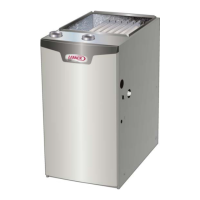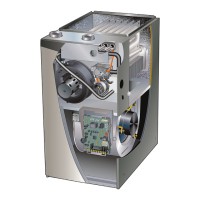Page 45
IV-HEATING SYSTEM SERVICE CHECKS
A-CSA Certication
All units are CSA design certied without modications.
Refer to the EL296UHE Installation Instruction.
B-Gas Piping
CAUTION
If a exible gas connector is required or allowed by
the authority that has jurisdiction, black iron pipe
shall be installed at the gas valve and extend outside
the furnace cabinet. The exible connector can then
be added between the black iron pipe and the gas
supply line.
WARNING
Do not over torque (800 in-lbs) or under torque (350
in-lbs) when attaching the gas piping to the gas
valve.
Gas supply piping should not allow more than 0.5”W.C.
drop in pressure between gas meter and unit. Supply gas
pipe must not be smaller than unit gas connection.
Compounds used on gas piping threaded joints should be
resistant to action of liqueed petroleum gases.
C-Testing Gas Piping
IMPORTANT
In case emergency shutdown is required, turn o the
main shut-o valve and disconnect the main power
to unit. These controls should be properly labeled
by the installer.
When pressure testing gas lines, the gas valve must be
disconnected and isolated. Gas valves can be damaged if
subjected to more than 0.5 psig (14” W.C.). See gure 51.
If the pressure is greater than 0.5psig (14”W.C.), use the
manual shut-o valve before pressure testing to isolate
furnace from gas supply.
MANUAL MAIN SHUT-OFF
VALVE WILL NOT HOLD
NORMAL TEST PRESSURE
CAP
FURNACE
ISOLATE
GAS VALVE
1/8” N.P. T. PLUGGED TAP
FIGURE 51
When checking piping connections for gas leaks, use
preferred means. Kitchen detergents can cause harmful
corrosion on various metals used in gas piping. Use of a
specialty Gas Leak Detector is strongly recommended. It
is available through Lennox under part number 31B2001.
See Corp. 8411-L10, for further details.
Do not use matches, candles, ame or any other
source of ignition to check for gas leaks.
D-Testing Gas Supply Pressure
An inlet post located on the gas valve provides access
to the supply pressure. See gure 50. Back out the 3/32
hex screw one turn, connect a piece of 5/16 tubing and
connect to a manometer to measure supply pressure. See
table 23 for supply line pressure.
E-Check Manifold Pressure
A manifold pressure post located on the gas valve pro-
vides access to the manifold pressure. See gure 50.
Back out the 3/32 hex screw one turn. Follow the steps
below and use gure 52 as a reference. Gas manifold Kit
10L34 provides additional components if needed
1 - Connect the 5/16” round tubing to the manifold post.
Secure with the clamp.
2 - Connect the reducer tting to the 5/16” round tubing
followed by a piece of 10” length square tubing.
3 - Connect the other end of the square tubing to the
“+” positive side of the measuring device.
4 - Take the 2” length square tubing, tee, 10” length of
square tubing and tee into the gas valve regulator
vent hose. Connect to the measuring device
negative “-” side.
5 - Ignite unit on low re and let run for 5 minutes to
allow for steady state conditions.
6 - After allowing unit to stabilize for 5 minutes, record
manifold pressure and compare to value given in
table 23 or 24.
7 - If necessary, make adjustments. Figure 50 shows
location of high re and low re adjustment screws.
8 - Repeat steps 5, 6 and 7 on high re. See values in
table 23 or 24.
9 - Shut unit o and remove manometer as soon as an
accurate reading has been obtained.
10 - Start unit and perform leak check. Seal leaks if
found.
IMPORTANT
For safety, connect a shut-o valve between the
manometer and the gas tap to permit shut o of gas
pressure to the manometer.

